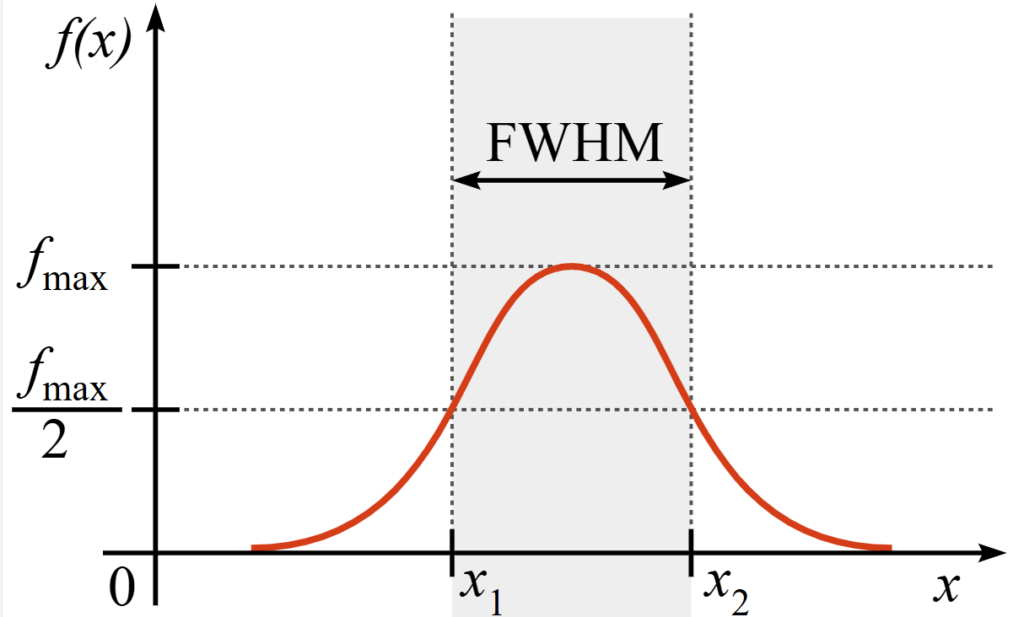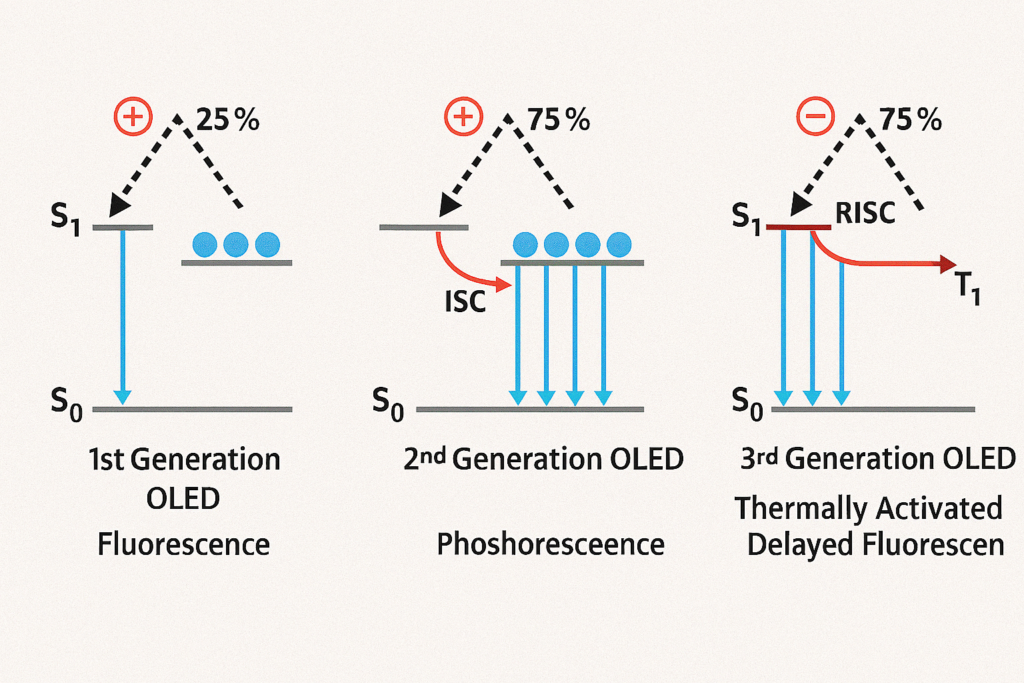
FWHM, or Full Width at Half Maximum, is a key parameter used across optics, spectroscopy, and display technology. Whether analyzing light emission, laser beams, or display color purity, FWHM serves as a standard way to measure the width of a spectral feature or intensity profile — offering insights into clarity, sharpness, resolution, and color performance.
What is FWHM and why does it matter? Eureka Technical Q&A explains that Full Width at Half Maximum measures the width of a spectral peak at half its maximum intensity—critical for understanding resolution and sharpness in optics, spectroscopy, and display technologies.
This article explains what FWHM is, how it works, and why it plays a vital role in optical systems, spectroscopy analysis, and modern display technologies.
What is FWHM (Full Width at Half Maximum)?
FWHM refers to the width of a curve or peak measured at half of its maximum intensity or height. It provides a consistent way to quantify the spread or sharpness of a signal, such as a light spectrum, laser beam, or emission line.
In simple terms:
- Narrow FWHM → Sharper peak, higher purity, better resolution
- Wide FWHM → Broader peak, lower purity, more mixed or spread light
FWHM is usually expressed in units like:
- Nanometers (nm) → in optics and displays
- Hertz (Hz) → in frequency domain
- Angstroms (Å) → in spectroscopy
- Degrees (°) → in beam divergence

How to Calculate FWHM
Full Width at Half Maximum is measured by:
- Finding the maximum intensity of the peak.
- Calculating half of that maximum value.
- Measuring the width of the curve at this half-maximum point.
Mathematically, for Gaussian profiles (common in optics), the relationship is:
FWHM = 2√(2 ln2) × σ ≈ 2.355 × σ
(Where σ is the standard deviation of the Gaussian curve)
This relationship helps convert between standard deviation and Full Width at Half Maximum values when analyzing symmetrical peaks.
Role of FWHM in Optics and Photonics
1. Laser Beam Quality
FWHM is used to measure the spectral width of lasers. A laser with a smaller Full Width at Half Maximum produces highly monochromatic (single-wavelength) light, essential for precision applications like:
- Optical communications
- Laser cutting
- Medical equipment
2. Optical Filters
Filters like bandpass filters specify their transmission range using Full Width at Half Maximum. A smaller FWHM allows the filter to pass only a narrow range of wavelengths, improving spectral selectivity.
3. LED and Laser Diodes
In LED and laser specifications, FWHM indicates the purity of emitted light. For example:
- Red LED: FWHM = 20–30 nm (broad)
- Laser: FWHM < 1 nm (narrow)
Importance of FWHM in Spectroscopy

Spectroscopy relies heavily on Full Width at Half Maximum to determine resolution and sensitivity in detecting materials and substances.
1. Emission and Absorption Spectra
- Atomic or molecular environments
- Temperature effects
- Material composition
- Line broadening due to collisions or Doppler effects
2. Raman and Photoluminescence Spectroscopy
Sharper (narrower) Full Width at Half Maximum values mean better ability to resolve closely spaced spectral features, critical in material identification or purity analysis.
3. X-ray and UV-Vis Spectroscopy
In analytical chemistry, narrower Full Width at Half Maximum values yield better resolution, allowing researchers to distinguish between similar compounds.
FWHM in Display Technology
In display engineering, Full Width at Half Maximum is used to describe the spectral width of RGB subpixels or backlight sources — directly influencing color quality and visual performance.
1. Color Purity
A narrow FWHM for red, green, and blue light leads to more saturated and accurate colors because there is less spectral overlap between different color channels.
2. Wide Color Gamut Displays
Technologies like:
- Quantum Dot Displays
- Mini-LED Backlights
- MicroLED
- Laser-based Displays
Utilize light sources with small FWHM to cover a wider color gamut like DCI-P3 or Rec.2020.
| Light Source | Typical FWHM | Impact on Color |
|---|---|---|
| White LED | 30–50 nm | Limited color saturation |
| Quantum Dot | 20–30 nm | Enhanced color accuracy |
| Laser Phosphor | 1–10 nm | Extremely pure colors |
Why FWHM Matters Across Industries
Optics and Imaging Applications
FWHM plays a key role in evaluating image quality and resolution in optical systems. It measures the width of the main lobe of the point spread function (PSF), helping determine a system’s ability to capture fine details. In microscopy and imaging, a smaller Full Width at Half Maximum ensures clearer images and better resolution. This accuracy is essential for precise observations and measurements in scientific and medical imaging.
Applications in Materials Science and Nanotechnology
Researchers often use FWHM to study the crystallinity and structure of materials. In X-ray diffraction (XRD) analysis, the Full Width at Half Maximum of peaks reveals information about crystal size, internal strain, and defects. Moreover, in nanotechnology, Full Width at Half Maximum describes the emission spectra of quantum dots and nanomaterials. This measurement helps improve the performance of display technology and advanced lighting systems.
Applications in Photonics and Lasers
In laser systems, Full Width at Half Maximum defines the spectral width and coherence of laser output. This measurement directly impacts the spectral purity and resolution of laser-based tools. In optical communication, the FWHM of laser emissions influences signal bandwidth and transmission efficiency. Narrower FWHM ensures better laser performance in many industrial and scientific applications.
Applications in Electronics and Semiconductor Devices
FWHM helps evaluate the performance of semiconductor devices like transistors and diodes. Engineers use it to optimize design and improve the functionality of these components. In LEDs and other light-emitting devices, the Full Width at Half Maximum of emission spectra affects color purity and brightness. Narrow Full Width at Half Maximum produces more vibrant and accurate lighting solutions.
Signal Processing and Communication Applications
In signal processing, FWHM helps analyze signal bandwidth and resolution. This measurement supports the design of better communication systems by improving signal clarity. In antenna design, reducing Full Width at Half Maximum in radiation patterns enhances directionality and communication efficiency. This improvement benefits radar systems, wireless networks, and satellite communications.
Metallurgy and Materials Characterization
In metallurgy, Full Width at Half Maximum provides insight into microstructural changes and residual stress in materials. It plays a vital role in processes like welding and grinding, helping evaluate the integrity and durability of metals. Engineers use this information to ensure the safe performance of structural components.
Environmental and Agricultural Applications
In environmental monitoring and agriculture, Full Width at Half Maximum supports the analysis of spectral data from sensors. Researchers use it to assess plant health and monitor environmental quality. A narrower Full Width at Half Maximum improves the accuracy of these measurements, leading to better resource management and environmental protection.
| Application | Impact of FWHM |
|---|---|
| Optics | Determines laser sharpness & filter precision |
| Spectroscopy | Controls spectral resolution & detection accuracy |
| Displays | Affects color purity, vibrancy, and gamut coverage |
| Lighting | Controls beam spread and uniformity |
| Telecommunications | Ensures signal clarity in fiber optics |
FWHM and Human Visual Perception
In displays, smaller FWHM values help:
- Reduce color mixing and bleeding
- Improve contrast and vividness
- Achieve more lifelike and accurate visuals
- Enhance viewing experience in HDR content
However, extremely narrow FWHM may cause unwanted effects like laser speckle or discomfort due to unnatural color rendering — highlighting the need for balance.
Challenges in Achieving Narrow FWHM
- Material limitations in emitters
- Stability issues in ultra-narrow spectrum sources
- Cost of manufacturing high-purity light sources
- Trade-offs between brightness and spectral sharpness
Innovations like advanced Quantum Dots, perovskite materials, and microcavity OLEDs aim to overcome these limitations.
Conclusion
FWHM is a critical parameter that links fundamental optics, advanced spectroscopy, and modern display technology. It provides a standard way to quantify sharpness, resolution, and color purity — impacting everything from lasers and sensors to smartphones and TVs.
As display technologies evolve and precision optics become more advanced, controlling and optimizing FWHM will continue to shape the future of visual and analytical systems.
FAQs
Full Width at Half Maximum measures how wide a peak or light emission is at half of its maximum intensity — indicating sharpness or spread.
Smaller Full Width at Half Maximum leads to purer colors, less overlap between RGB channels, and wider color gamut capabilities.
Yes. Ultra-narrow Full Width at Half Maximum may reduce brightness, requiring more powerful light sources to maintain vivid images.
Quantum Dots in displays typically have a Full Width at Half Maximum between 20 and 30 nm, balancing color purity and brightness.
Absolutely. Full Width at Half Maximum applies to sound waves, frequency signals, X-ray peaks, and any field involving wave or signal analysis.
To get detailed scientific explanations of FWHM, try Patsnap Eureka.


